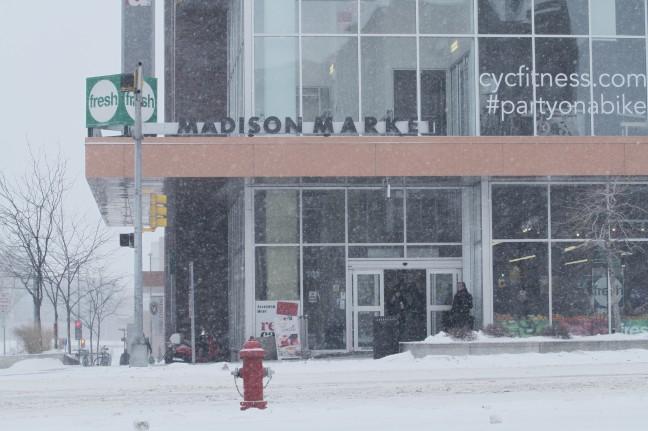Walking back from class during these frigid winter months, I take in the familiar surroundings of students wrapping their parkas more tightly around themselves, slightly hunched over, feet shuffling quickly back to their respective homes. There’s one more detail usually included in the scene: Fresh Madison Market bags being toted along, the green logo unmistakably apparent. Considering its convenient location on campus, it’s obvious why Fresh is well frequented, and the monopoly it holds over other grocery stores is clear.
According to Fresh, it serves 25,000 University of Wisconsin students — nearly 60 percent of the student population. Its prices cannot quite be called reasonable, but it maintains a secure popularity due, at least in part, to lack of readily accessible competition on campus.
Madison is a city known for its wide variety of superb cuisine with countless restaurants and cafes interspersed throughout. The large number of eateries, however, is not supplemented by readily accessible and affordable grocery stores. Even with additional support coming from the smaller (half the square footage of Fresh) Capitol Centre Market, the populous area of downtown Madison is left with much to be desired.
Off-campus options are abundant and include Whole Foods on University Ave, Trader Joe’s on Monroe St. and Metcalfe’s Market about three miles away. Shopping at these stores is certainly possible, yet the distance does not encourage it. In a city filled with overly busy and way-too-stressed college students, the vast majority of whom are without cars, convenience is key. For a student without access to a car, these locations constitute a 20-minute bus ride in either direction.
On that note, the lack of grocery options does secure University Dining and Culinary Services profit, making dining halls such as Gordon Dining and Event Center or Four Lakes Market advantageous for those unable to cook. Be that as it may, the dining halls fail to compete nutritionally with what the typical grocery store can offer: a wide selection of crisp produce, ample whole grains and lean meats that make up a healthy diet. The inexpensive, centrally located Kwik Trip on Randall Avenue is a more attractive choice for the average college student, although similarly unhealthy, with selections including $1 specials on pizza and cheeseburgers.
Additionally, as the city of Madison appeals to more young professionals, there is a noticeable increase in new apartments being built on campus. Considering the growing demand for housing, it seems logical that the demand for food should increase as well, as less residents then rely on the dining halls and the university-affiliated convenience store Flamingo Run. In fact, the development of the Lucky apartment building was able to secure Fresh itself. However, while other, typically unhealthy, convenience stores are springing up, such as a 7-Eleven rumored to be going in near the University Bookstore, the development of new grocery stores is failing to rise with that of apartment buildings.
Furthermore, a more competitive market could benefit the student body as a whole. Competition spurs lower prices and higher quality products as entities attempt to attract more customers. Fresh, comfortably situated in a position with little competition, is thus able to charge higher prices for its products.
Considering the size of the university campus, the sheer number of the student body, and the ever-developing downtown section of Madison, it is surprising that there are not more groceries available. While this does indeed protect university profit through the dining halls, it has increased the demand of a smaller supply of food options, thus increasing prices. For the average college student, this type of situation is undesirable, and in my opinion, a cause for comment.
Megan Stefkovich ([email protected]) is a freshman majoring in biology.














